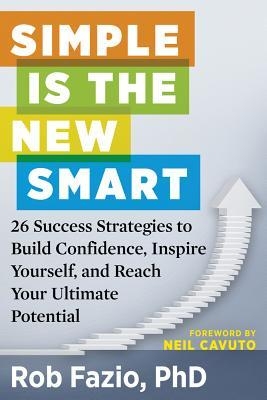
“Simple is the New Smart – 26 Success Strategies to Build Confidence, Inspire Yourself and Reach Your Ultimate Potential” by Rob Fazio (Career Press, $15.99).
There are no shortcuts to success; but there are smartcuts that make success easier to achieve. Fazio’s 26 smartcuts are rooted in “See it, Say it, Start it.”
See it creates the vision of what you’re learning or trying to achieve. Say it relates to how clearly and concisely you communicate that vision to yourself and others. Start it involves the habits you adopt that drive the actions needed to learn and achieve.
Of the 26, these top my list:
2. “Put doubts in your doubts.” The fear of failure raises the specter of doubt in everyone. Doubt begets indecision and inactions, which erode both self-confidence and competence. Think about them as emotional obstacles preventing achievement – obstacles over which you have total control. Exercise that control by thinking “How will I …?” rather than “I can’t.” The … “How will I …?” step represents doing something. The more you do, the less doubt you have about doing even more.
4. “Helplessness, the Victim Mentality.” While doubt involves emotional obstacles you can control, helplessness deals with things outside of your control. Recognize that while you don’t control the situation, you always control your response to it. Victims disengage and feel powerless; owners engage through adaptation. They identify the skills they have and how those skills will help them. Just as important, they identify other skills they need to deal with the situation and acquire them.
8. “The blind side.” Blind spots are things you say, do or demonstrate that have negative impacts of which you’re unaware, but are apparent to those with whom you work. It takes courage to ask others about your blind spots. Asking “how can I improve” questions will lead to honest feedback because you’re acknowledging that there’s room for improvement. Responding positively to their feedback shows you value their input. This increases mutual trust and respect, which ensures that channels of communication remain open. The more open they are, the less likelihood blind spots will inhibit productivity.
14. “Innovation evaporation.” Don’t think of innovation in terms of ‘the next big thing.’ See it as an integral part of the process of continuous improvement – for both you and the firm. As part of that process, it makes change the norm.
While it may involve doing different things, it may involve doing things differently. By asking how we can work better, faster, smarter, etc., you create space for all to think differently. Sharing thoughts with a group lets others add their perspectives, which leads to an expanded version of “what could happen if.” Group input = group buy-in, which make the change easier to sell.
26. “The crazy and the lazy.” What should you do when your motivation meets the resistance of naysayers who prefer the same-old-same-old-tired-and-true? First, recognize that you’re not going to persuade them. Limit interactions with them. Second, identify those with open minds and engage them around finding solutions, not carping about problems. Successful engagement involves three steps: 1. Communicate your message with clarity. 2. Establish common ground by asking questions about the effects of the problem on their productivity. When someone identifies “what’s in it for me,” she/he becomes an ally.
The more allies you have, the less likelihood naysayers will be able to derail the solution.
Fazio’s message: If you want to increase your momentum, get out of your own way.
Jim Pawlak is a nationally syndicated reviewer of business books.







